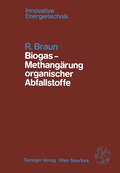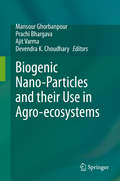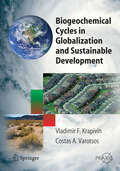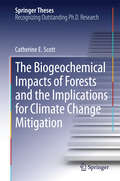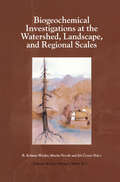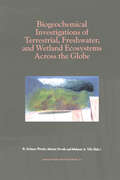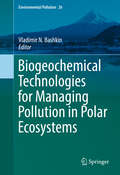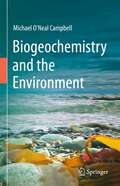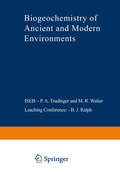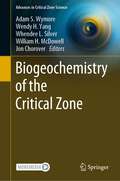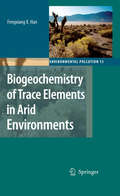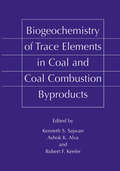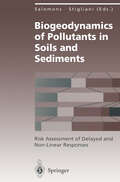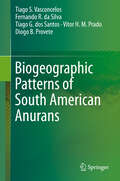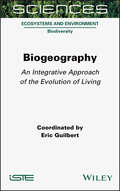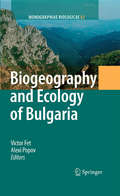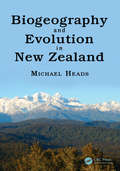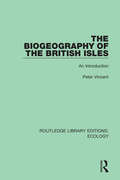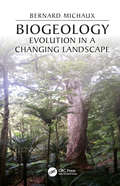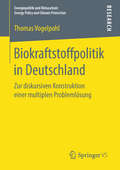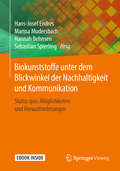- Table View
- List View
Biogas — Methangärung organischer Abfallstoffe: Grundlagen und Anwendungsbeispiele (Innovative Energietechnik)
by R. BraunBiogenic Nano-Particles and their Use in Agro-ecosystems
by Ajit Varma Devendra K. Choudhary Mansour Ghorbanpour Prachi BhargavaSeveral nano-scale devices have emerged that are capable of analysing plant diseases, nutrient deficiencies and any other ailments that may affect food security in agro-ecosystems. It has been envisioned that smart delivery systems can be developed and utilised for better management of agricultural ecosystems. These systems could exhibit beneficial, multi-functional characteristics, which could be used to assess and also control habitat-imposed stresses to crops.Nanoparticle-mediated smart delivery systems can control the delivery of nutrients or bioactive and/or pesticide molecules in plants. It has been suggested that nano-particles in plants might help determine their nutrient status and could also be used as cures in agro-ecosystems. Further, to enhance soil and crop productivity, nanotechnology has been used to create and deliver nano fertilizers, which can be defined as nano-particles that directly help supply nutrients for plant growth and soil productivity. Nano-particles can be absorbed onto clay networks, leading to improved soil health and more efficient nutrient use by crops. Additionally, fertilizer particles can be coated with nano-particles that facilitate slow and steady release of nutrients, reducing loss of nutrients and enhancing their efficiency in agri-crops. Although the use of nanotechnology in agro-ecosystems is still in its early stages and needs to be developed further, nano-particle-mediated delivery systems are promising solutions for the successful management of agri-ecosystems. In this context, the book offers insights into nanotechnology in agro-ecosystems with reference to biogenic nanoparticles. It highlights the: • occurrence and diversity of Biogenic Nanoparticles• mechanistic approach involved in the synthesis of biogenic nanoparticles• synthesis of nanoparticles using photo-activation, and their fate in the soil ecosystem• potential applications of nanoparticles in agricultural systems• application and biogenic synthesis of gold nanoparticles and their characterization• impact of biogenic nanoparticles on biotic stress to plants• mechanistic approaches involved in the antimicrobial effects and cytotoxicity of biogenic nanoparticles• role of biogenic nanoparticles in plant diseases management• relevance of biological synthesized nanoparticles in the longevity of agricultural crops • design and synthesis of nano-biosensors for monitoring pollutants in water, soil and plant systems• applications of nanotechnology in agriculture with special refer to soil, water and plant sciencesA useful resource for postgraduate and research students in the field of plant and agricultural sciences, it is also of interest to researchers working in nano and biotechnology.
Biogeochemical Cycles in Globalization and Sustainable Development (Springer Praxis Books)
by Vladimir F. KrapivinThis book presents a new approach to the study of global environmental changes that have unfavorable implications for people and other living systems. The book benefits from the accumulation of knowledge from different sciences. Basic global problems of the nature-society system dynamics are considered. The book aims to develop a universal information technology to estimate the state of environmental subsystems functioning under various climatic and anthropogenic conditions.
The Biogeochemical Impacts of Forests and the Implications for Climate Change Mitigation (Springer Theses)
by Catherine E. ScottForests and vegetation emit biogenic volatile organic compounds (BVOCs) into the atmosphere which, once oxidized, can partition into the particle phase, forming secondary organic aerosols (SOAs). This thesis reports on a unique and comprehensive analysis of the impact of BVOC emissions on atmospheric aerosols and climate. A state-of-the-art global aerosol microphysics model is used to make the first detailed assessment of the impact of BVOC emissions on aerosol microphysical properties, improving our understanding of the role of these emissions in affecting the Earth’s climate. The thesis also reports on the implications for the climate impact of forests. Accounting for the climate impacts of SOAs, taken together with the carbon cycle and surface albedo effects that have been studied in previous work, increases the total warming effect of global deforestation by roughly 20%.
Biogeochemical Investigations at Watershed, Landscape, and Regional Scales: Refereed papers from BIOGEOMON, The Third International Symposium on Ecosystem Behavior; Co-Sponsored by Villanova University and the Czech Geological Survey; held at Villanova University, Villanova Pennsylvania, USA, June 21–25, 1997
by R. Kelman Wieder Martin Novák Jiří ČernýThis Special Issue of Water, Air, and Soil Pollution offers original contributions from BIOGEOMON, The Third International Symposium on Ecosystem Behavior, which was held on the campus ofVillanova University from June 21-25, 1997. Previous meetings were held in Prague in 1987 and again in 1993. The BIOGEOMON series was initiated in 1987 when a group of researchers from the Czech Geological Survey organized a conference called GEOMON, Geochemical Monitoring in Representative Basins. GEOMON was fairly narrowly focused on monitoring of element pools and fluxes on a small watershed scale. As signalled by the change in name to BIOGEOMON, the second conference explicitly recognized that assessment of anthropogenic effects on ecosystem processes requires a combination of geochemical monitoring with other approaches, including watershed-level manipulations, use of radioactive and stable isotopic tracers, and both empirical and process modeling. The 1997 BIOGEOMON conference was the largest, with over 240 participants from 28 countries on five continents in attendance, and broadest in scope. The conference featured a plenary speaker, six keynote speakers, 35 invited speakers, over 60 oral contributed presentations, and over 75 poster presentations.
Biogeochemical Investigations of Terrestrial, Freshwater, and Wetland Ecosystems across the Globe
by R. Kelman Wieder Martin Novák Melanie A. VileHere is a collection of papers from BIOGEOMON, The Fourth International Symposium on Ecosystem Behavior. The contributions address a wider-than-ever range of concerns: aspects of catchment monitoring and modeling; nitrogen transformations and processes; stable and radiogenic isotopes; biogeochemistry of restored ecosystems; and the dynamics of such chemicals as mercury and phosphorous, among many other topics.
Biogeochemical Technologies for Managing Pollution in Polar Ecosystems (Environmental Pollution #26)
by Vladimir N. BashkinThis edited book is devoted to environmental risk management in gas industry impacted polar ecosystems of Russia, one of the hottest topics of modern environmental science. The contributions from experts cover topics that shed new light on the impacts of oil and natural gas production on arctic ecosystems in the country as well as biogeochemical engineering technologies to manage pollution in these areas. Readers will also discover new insights on potential ecological indicators for assessing geo-environmental risks of these impacted ecosystems, and climate modeling in polar areas. The book has interdisciplinary appeal, and specialists and practitioners in environmental sciences, ecology, biogeochemistry and those within the energy sector who are interested in understanding ecosystems affected by anthropogenic impacts in severe climatic conditions will find it particularly engaging. Through this book, readers will learn more about biogeochemical cycling through food chains and specific reactions of biota to environmental pollution in extreme environments through the lens of experts.
Biogeochemistry and the Environment
by Michael O'Neal CampbellBiogeochemistry may be defined as the science that combines biological and chemical perspectives for the examination of the Earth’s surface, including the relations between the biosphere, lithosphere, atmosphere, and hydrosphere. Biogeochemistry is a comparatively recently developed science, that incorporates scientific knowledge and findings, research methodologies, and models linking the biological, chemical, and earth sciences. Therefore, while it is a definitive science with a strong theoretical core, it is also dynamically and broadly interlinked with other sciences. This book examines the complex science of biogeochemistry from a novel perspective, examining its comparatively recent development, while also emphasizing its interlinked relationship with the earth sciences (including the complementary science of geochemistry), the geographical sciences (biogeography, oceanography, geomatics, earth systems science), the biological sciences (ecology, wildlife studies, biological aspects of environmental sciences) and the chemical sciences (including environmental chemistry and pollution). The book covers cutting-edge topics on the science of biogeochemistry, examining its development, structure, interdisciplinary, multidisciplinary, and transdisciplinary relations, and the future of the current complex knowledge systems, especially in the context of technological, developments, and the computer and data fields.
Biogeochemistry of Ancient and Modern Environments: Proceedings of the Fourth International Symposium on Environmental Biogeochemistry (ISEB) and, Conference on Biogeochemistry in Relation to the Mining Industry and Environmental Pollution (Leaching Conference), held in Canberra, Australia, 26 August – 4 September 1979
by P. A. Trudinger M. R. Walter B. J. RalphThis volume contains a selection of papers presented to the Fourth International Symposium on Environmental Biogeochemistry (ISEB), and a conference on Biogeochemistry in Relation to Mining Industry and Environmental Pollution (Leaching Conferenc~, held in Canberra, Aust ralia on August 26-31 and September 3-4, 1979, respectively. The ISEB were established to provide "a forum for uninhibited exchange of information and ideas among the biological, chemical, atmospheric and geolopical scientists working in the common area of biogeochemistry, encompassing soil and other earth sciences as weIL as the hydrosphere and atmosphere", By linking the fourth ISEB with the Leachinp Conference the scop.e of discussions was extended to encompass the application of biogeochemical processes to the mining industry. This wide-ranging philosophy is reflected in the breadth and diversity of the subjects covered in this book. The published papers are expanded versions of those presented at the meetings. They have all been scrutinized by at least one referee in addition to the editors. About 20% of the contributions to the meetings are not included, either because authors did not wish to publish or because the papers were not accepted by the editors.
Biogeochemistry of the Critical Zone (Advances in Critical Zone Science)
by Adam S. Wymore Wendy H. Yang Whendee L. Silver William H. McDowell Jon ChoroverThis book highlights recent advances in the discipline of biogeochemistry that have directly resulted from the development of critical zone (CZ) science. The earth's critical zone (CZ) is defined from the weathering front and lowest extent of freely circulating groundwater up through the regolith and to the top of the vegetative canopy. The structure and function of the CZ is shaped through tectonic, lithologic, hydrologic, climatic, and biological processes and is the result of processes occurring at multiple time scales from eons to seconds. The CZ is an open system in which energy and matter are both transported and transformed. Critical zone science provides a novel and unifying framework to consider those coupled interactions that control biogeochemical cycles and fluxes of energy and matter that are critical to sustaining a habitable planet. Biogeochemical processes are at the heart of energy and matter fluxes through ecosystems and watersheds. They control the quantity and quality of carbon and nutrients available for living organisms, control the retention and export of nutrients affecting water quality and soil fertility, and influence the ability for ecosystems to sequester carbon. As the term implies, biogeochemical cycles, and the rates at which they occur, result from the interaction of biological, chemical, and physical processes. However, finding a unifying framework by which to study these interactions is challenging, and the different components of bio-geo-chemistry are often studied in isolation. The authors provide both reviews and original research contributions with the requirement that the chapters incorporate a CZ framework to test biogeochemical theory and/or develop new and robust predictive models regarding elemental cycles. The book demonstrates how the CZ framework provides novel insights into biogeochemistry.
Biogeochemistry of Trace Elements in Arid Environments (Environmental Pollution #13)
by Fengxiang X. HanThis book offers comprehensive coverage of trace elements in arid zone regions. It begins by introducing the nature and properties of arid zone soil, followed by coverage of the major aspects of the trace elements and heavy metals of most concern in the world’s arid and semi-arid soils. A comprehensive, focused case study on transfer fluxes of trace elements in Israeli arid soils is used to illustrate the themes presented in the book.
Biogeochemistry of Trace Elements in Coal and Coal Combustion Byproducts
by Robert F. Keefer Ashok K. Alva Kenneth S. SajwanThe research papers in this book present current knowledge of the sources, pathways, behavior, and effects of trace elements in soils, waters, plants, and animals. It is of interest to a variety of readers, including public health and environmental professionals, consultants, and academicians.
Biogeodynamics of Pollutants in Soils and Sediments: Risk Assessment of Delayed and Non-Linear Responses (Environmental Science and Engineering)
by William M. Stigliani WimSalomonsIn the USA, Western and Central Europe, there are many large-scale polluted sites that are too large to be cleaned up economically with available technologies. The pollution is caused by heavy industries to soils and sediments in waterways and reservoirs. Since these areas are expected to remain polluted for many years, it is necessary to take a long-term view to insure that the capacity to retain the contaminants is not diminished and to understand the potential for large-scale contaminant mobilization at these sites triggered by changing environmental conditions. This book provides information for predicting long-term changes and making risk assessments and describes the approach of geochemical engineering to handling large-scale polluted sites.
Biogeographic Patterns of South American Anurans
by Tiago S. Vasconcelos Fernando R. da Silva Tiago G. dos Santos Vitor H. Prado Diogo B. ProveteThis book analyzes different facets of anuran amphibian distribution in South America. We integrate alternative biological metrics employing cutting-edge methods to understand the dynamic processes underlying species distribution patterns. By using the modern biogeographic toolbox, we explore how richness gradients, phylogenetic diversity, functional diversity, and range size/endemism distribution of amphibians vary along the continent. Moreover, we present a robust proposal for priority areas for conservation of anurans in South America that maximizes representativeness of distinct biodiversity facets.
Biogeography: An Integrative Approach of the Evolution of Living
by Eric GuilbertThe recent progress in analytical methods, aided by bringing in a wide range of other disciplines, opens up the study to a broader field, which means that biogeography now goes far beyond a simple description of the distribution of living species on Earth.Originating with Alexander von Humboldt, biogeography is a discipline in which ecologists and evolutionists aim to understand the way that living species are organized in connection with their environments. Today, as we face major challenges such as global warming, massive species extinction and devastating pandemics, biogeography offers hypotheses and explanations that may help to provide solutions.This book presents as wide an overview as possible of the different fields that biogeography interacts with. Sixteen authors from all over the world offer different approaches based on their specific areas of knowledge and experience; thus, we intend to illustrate the vast number of diverse aspects covered by biogeography.
Biogeography: An Integrative Approach of the Evolution of Living
by Eric GuilbertThe recent progress in analytical methods, aided by bringing in a wide range of other disciplines, opens up the study to a broader field, which means that biogeography now goes far beyond a simple description of the distribution of living species on Earth.Originating with Alexander von Humboldt, biogeography is a discipline in which ecologists and evolutionists aim to understand the way that living species are organized in connection with their environments. Today, as we face major challenges such as global warming, massive species extinction and devastating pandemics, biogeography offers hypotheses and explanations that may help to provide solutions.This book presents as wide an overview as possible of the different fields that biogeography interacts with. Sixteen authors from all over the world offer different approaches based on their specific areas of knowledge and experience; thus, we intend to illustrate the vast number of diverse aspects covered by biogeography.
Biogeography and Ecology of Bulgaria (Monographiae Biologicae #82)
by Victor Fet Alexi PopovFrom single-celled organisms in Black Sea sand to endemic cave crustaceans, from mountain glacial relict insects to the most diverse bird fauna in Europe, the fauna of Bulgaria has been a subject of study for more than a century. This is the first English language survey of all vertebrate and many key invertebrate groups of Bulgaria, their faunistics, origin, geographical and ecological distribution, and conservation issues.
Biogeography and Evolution in New Zealand (CRC Biogeography Series)
by Michael HeadsBiogeography and Evolution in New Zealand provides the first in-depth treatment of the biogeography of New Zealand, a region that has been a place of long-enduring interest to ecologists, evolutionary scientists, geographers, geologists, and scientists in related disciplines. It serves as a key addition to the contemporary discussion on regionalization—how is New Zealand different from the rest of the world? With what other areas does it share its geology, history, and biota? Do new molecular phylogenies show that New Zealand may be seen as a biological ‘parallel universe’ within global evolution?
Biogeography and Evolution in New Zealand (CRC Biogeography Series #1)
by Michael HeadsBiogeography and Evolution in New Zealand provides the first in-depth treatment of the biogeography of New Zealand, a region that has been a place of long-enduring interest to ecologists, evolutionary scientists, geographers, geologists, and scientists in related disciplines. It serves as a key addition to the contemporary discussion on regionalization—how is New Zealand different from the rest of the world? With what other areas does it share its geology, history, and biota? Do new molecular phylogenies show that New Zealand may be seen as a biological ‘parallel universe’ within global evolution?
The Biogeography of the British Isles: An Introduction (Routledge Library Editions: Ecology #17)
by Peter VincentOriginally published in 1990, The Biogeography of the British Isles is devoted to the biogeography of the British Isles and surrounding shelf seas. Bringing together a wealth of diverse information, it is thoroughly referenced and well illustrated, and will be invaluable to students of geography, environmental science, ecology, botany, and zoology. The book traces the development of British biogeography over the last two centuries, examining key topics such as ecosystems, habitats, and niches in the context of plant and animal distribution. The book gives a detailed account of the development of biogeographical mapping and recording systems, and describes modern-day distributions, both in the countryside and in urban areas against the backcloth of human activities.
The Biogeography of the British Isles: An Introduction (Routledge Library Editions: Ecology #17)
by Peter VincentOriginally published in 1990, The Biogeography of the British Isles is devoted to the biogeography of the British Isles and surrounding shelf seas. Bringing together a wealth of diverse information, it is thoroughly referenced and well illustrated, and will be invaluable to students of geography, environmental science, ecology, botany, and zoology. The book traces the development of British biogeography over the last two centuries, examining key topics such as ecosystems, habitats, and niches in the context of plant and animal distribution. The book gives a detailed account of the development of biogeographical mapping and recording systems, and describes modern-day distributions, both in the countryside and in urban areas against the backcloth of human activities.
Biogeology: Evolution in a Changing Landscape (CRC Biogeography Series)
by Bernard MichauxThis detailed exposition gives background and context to how modern biogeography has got to where it is now. For biogeographers and other researchers interested in biodiversity and the evolution of life on islands, Biogeology: Evolution in a Changing Landscape provides an overview of a large swathe of the globe encompassing Wallacea and the western Pacific. The book contains the full text of the original article explored in each chapter, presented as it appeared on publication. Key features: Holistic treatment, collecting together a series of important biogeographical papers into a single volume Authored by an expert who has spent nearly three decades actively involved in biogeography Describes and interprets a region of exceptional biodiversity and extreme endemism The only book to provide an integrated treatment of Wallacea, Melanesia, New Zealand, the New Zealand Subantarctic Islands and Antarctica Offers a critique of fashionable neo-dispersalist arguments, showing how these still suffer from the same weaknesses of the original Darwinian formulation. The chapters also include analysis of many major theoretical and philosophical issues of modern biogeographic theory, so that those interested in a more philosophical approach will find the book stimulating and thought-provoking.
Biogeology: Evolution in a Changing Landscape (CRC Biogeography Series)
by Bernard MichauxThis detailed exposition gives background and context to how modern biogeography has got to where it is now. For biogeographers and other researchers interested in biodiversity and the evolution of life on islands, Biogeology: Evolution in a Changing Landscape provides an overview of a large swathe of the globe encompassing Wallacea and the western Pacific. The book contains the full text of the original article explored in each chapter, presented as it appeared on publication. Key features: Holistic treatment, collecting together a series of important biogeographical papers into a single volume Authored by an expert who has spent nearly three decades actively involved in biogeography Describes and interprets a region of exceptional biodiversity and extreme endemism The only book to provide an integrated treatment of Wallacea, Melanesia, New Zealand, the New Zealand Subantarctic Islands and Antarctica Offers a critique of fashionable neo-dispersalist arguments, showing how these still suffer from the same weaknesses of the original Darwinian formulation. The chapters also include analysis of many major theoretical and philosophical issues of modern biogeographic theory, so that those interested in a more philosophical approach will find the book stimulating and thought-provoking.
Biokraftstoffpolitik in Deutschland: Zur diskursiven Konstruktion einer multiplen Problemlösung (Energiepolitik und Klimaschutz. Energy Policy and Climate Protection)
by Thomas VogelpohlBiokraftstoffe werden bereits seit den 1980er Jahren als eine potenzielle Lösung für eine Vielzahl von Problemen propagiert: von der Ölabhängigkeit über den Strukturwandel der Landwirtschaft bis hin zum Klimawandel. Vor dem Hintergrund des sprunghaften, teils widersprüchlichen Verlaufs der deutschen Biokraftstoffpolitik zeichnet Thomas Vogelpohl die gesellschaftliche Konstruktion von Biokraftstoffen in den letzten dreißig Jahren sowie ihre Reflexion in politischen Entscheidungen diskursanalytisch nach. Er untersucht, wie Biokraftstoffe in Deutschland als politische Lösungsoption Geltung erlangen und behaupten konnten und wie dieser komplexe soziale Konstruktionsprozess vor dem Hintergrund der historisch spezifischen politisch-institutionellen und paradigmatischen Rahmenbedingungen verstanden werden kann.
Biokunststoffe unter dem Blickwinkel der Nachhaltigkeit und Kommunikation: Status quo, Möglichkeiten und Herausforderungen
by Hans-Josef Endres Marina Mudersbach Hannah Behnsen Sebastian SpierlingDas Buch zeigt, wie eine Nachhaltigkeitsbewertung von Biokunststoffen gelingen kann und wie die Ergebnisse einer solchen Bewertung ausfallen. Es analysiert die öffentliche Wahrnehmung beim Verbraucher sowie die politischen Rahmenbedingungen von Biokunststoffen.
